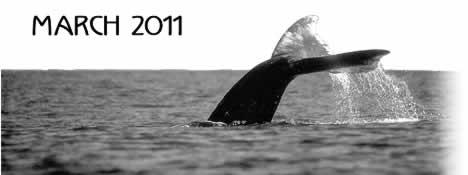
Food from the Ocean:
Weeds of the Sea
by Morgan Callison, Tofino
 Thankfully, they left some for us. The whales. Those magnificent creatures. When I heard they were coming I started to panic… just a little bit though… nothing too serious, some minor heart palpitations, clammy hands, my face awash with white, and a bit of a furrow of my brow. All of that was quickly wiped away though when I realized that whales don’t actually eat seaweed. Oh yes, they’ve left it for us!
Thankfully, they left some for us. The whales. Those magnificent creatures. When I heard they were coming I started to panic… just a little bit though… nothing too serious, some minor heart palpitations, clammy hands, my face awash with white, and a bit of a furrow of my brow. All of that was quickly wiped away though when I realized that whales don’t actually eat seaweed. Oh yes, they’ve left it for us!
How lucky are we to live so close to this amazing ocean that is so full of food?! Pretty darn lucky I’d say. Usually, when most people think of seafood, they think about salmon and halibut, tuna, crabs, oysters, clams and mussels. When the word seafood pops into my mind, I think about all of the weeds that grow in that salty water. And weeds they are. Growing so fast and abundantly, offering themselves up to anything and anyone who feels the desire to nibble on some beautifully and naturally grown ocean greens. Food doesn’t get much more wild and organic than that!
Seaweed season starts in the spring (March 20) and ends at the beginning of fall (Sep. 21). It is always nice when one thing ends and another begins. Continuity in the cycles of life. Only recently did I discover that there are over 600 species of seaweeds in the waters around Vancouver Island and every single one of them is edible. That’s a whole lotta food just floating around out there waiting to be gobbled up. Of course, us humans are not the only ones that like to indulge on these tasty delights. Sea otters, seals, some species of fish and sea urchins love the stuff. But since they are weeds, there is plenty enough for all!
Even though there are hundreds and hundreds of varieties of sea vegetables around, not a lot of them are commercially harvested, so quite often, much of what you’ll find at the grocery store actually comes from Japan. This seems a little bit silly to me since we have so much right here in our very own back basin. But, imported seaweed is still really good for you as far as nutrition goes so you don’t need to dismiss is altogether. Try to remember though to always be thoughtful about where your food comes from and how far it has traveled to get here and what that may mean in regards to environmental and social impacts. We also have to remember to be grateful to those folks who have been so influential on us in regards to taking advantage of all of the great vegetable based foods available from the sea. Sushi has introduced sea vegetables into the mainstream and is enjoyed by many here in the western parts of the world thanks to globalization and cross cultural interaction.
If you happen to know someone who loves to muck & wade about in the shallow waters around the coastlines of Vancouver Island you’re one step closer to some hands-on local seaweed education. Visiting the seaweed lady of Sooke is definitely on my list of things to do next time I visit the south end of the island. Until then, I’ll share with you what I know about the benefits and beauty of dealing with and dosing up on the weeds.
Sea asparagus is amazing. Tiny little sprigs of crunchy salty greenness. This is one sea vegetable that is used in it’s fresh form rather than dried like most of them are. This one can definitely be locally harvested, you just need to know where to go and that I’m not totally sure of. I did pick a mini harvest along the beaches of Fanny Bay a couple springs ago but that was not the sea asparagus jackpot by any means. If, like me, you’re not quite sure where to find it in the wilds, you’ll surely find it in the spot light on spring and summer restaurant menus and in the local health food stores. It can be eaten raw, tossed in salads or as a crispy snack all on it’s own. It’s also pretty awesome thrown into a stir-fry right at the last minute so that it maintains it’s original crispy texture. Like most seaweeds, it’s a great alternative to adding salt to your dish. A 2 in 1 if you will. So far, I haven’t come across anyone who hasn’t liked it as soon as they’ve tried it. Sea asparagus is super helpful in the detoxification of your whole body and also helps protect your liver and DNA which means a healthier person all around. Some say it is a superfood of the seas!
Macro kelp – this ones a local as well. Harvested commercially right from the waters of Barkley Sound. As is the case with the majority of seaweeds brought to market, macro kelp is dried before it gets packaged up and eaten. This is a light seaweed, with mild “sea” flavour making it a good one for those who are just beginning to introduce this category of food into their diet. This one can also be eaten as is or toasted for a richer experience. Crumble it up and add it to soup, rice or anything else you desire. Macro kelp is a great source of all trace minerals and contains fair amounts of iodine which is needed for proper thyroid function. There are many other types of kelp as well, bull kelp is amazing when pickled bread and butter style (nice work ladies and gents of the Tofino Community Food Initiative... please make more this year!). Kelp noodles can be found at specialty food shops – delightfully textured, neutral noodles that can be eaten raw or cooked in a variety ways.
Seaweeds are said to help eliminate heavy metals from the body, increase nutrient density in the bodily systems and possibly help reduce the absorption of radioactive compounds that are commonly found in the environment. As long as your seaweeds are coming from clean waters, you’ll be doing yourself good by getting them onto your plate and into your mouth. So, keep your eyes open and your adventurous spirit alive, while letting your taste buds decide for themselves and you may quickly be led to to love what the whales have left behind.
Morgan Callison runs Green Soul Organics and is a budding nutritionist.
Tofino Time March 2011
- Tofino Time Readers’ Choice Awards 2011:
The Best of Tofino 2010 - Tofino Surf: Pumping on a Frontside Wave
- Tofino tides: Tide table for Tofino March 2011
- Tofino surf reports for March 2011
- Tofino concerts in March 2011
- Movies in Tofino: March 2011
- Tofino events in March 2011
- Grey Whales in our Back Yard
- Commuters at Sea: What keeps Gray Whales going?
- Wildlife photographer Matthew Maran
- Pacific Rim Whale Festival: March 19-27, 2011
- Artsplash! Pacific Rim Arts Society Spring Art Festival 2011
- Whale Festival poster artist: Mark Hobson
- Food from the Ocean: Weeds of the Sea
- Tofino gardening tips for March 2011
- Tofino yoga classes in March
- Horoscope for March 2011
- West Coast Winter Music Series 2010/11
- Community Directory: Goods & Services in Tofino
tofino | tofino time | activities | accommodation | events | directory
maps | travel | food | art & artists | photos | horoscope | tides
search | magazine | issues | articles | advertising | contact us
hosted in tofino by tofino.net & studio tofino
© 2002-2014 copyright Tofino Time Magazine in Tofino Canada
Food from the ocean in Tofino consists not only of seafood in a classical sense, but also sea vegetable from sea asparagus to macro kelp.

quick links:
- tofino accomodations
- tofino calendar
- tofino surf report
- tofino horoscope
- march horoscope
- tofino map
- tofino fishing report
- tofino tides
- tofino weddings
tofino events:
- tofino concerts
- tofino events
- tofino movies
- tofino festivals
- tofino yoga classes
- tofino whale festival
tofino time magazine:
- tofino time march 2016
- tofino event listings march 2016
- tofino concerts in march 2016
- tofino movies in march 2016
- cox bay | wickaninnish beach
- chesterman beach
- tonquin beach
- tofino brewing co.
- tofino wedding guide
tofino accommodation:
- tofino cabin
- tofino camping
- bed & breakfasts in Tofino
- tofino hostels
- tofino motels
- tofino hotels
- tofino vacation rentals
- petfriendly accommodation
activities:
- tofino bike rentals
- tofino bear watching
- tofino bird watching
- tofino boat charters & cruises
- tofino fishing
- hot springs cove
- sea kayaking in tofino
- tofino storm watching
- tofino surfing
- tofino whale watching
- tofino yoga
shopping:
services:
- tofino yoga, spa & wellness
- tofino restaurants
- tofino internet cafes
- tofino travel & transportation
- tofino real estate
- tofino taxi services
- tofino wedding & events
